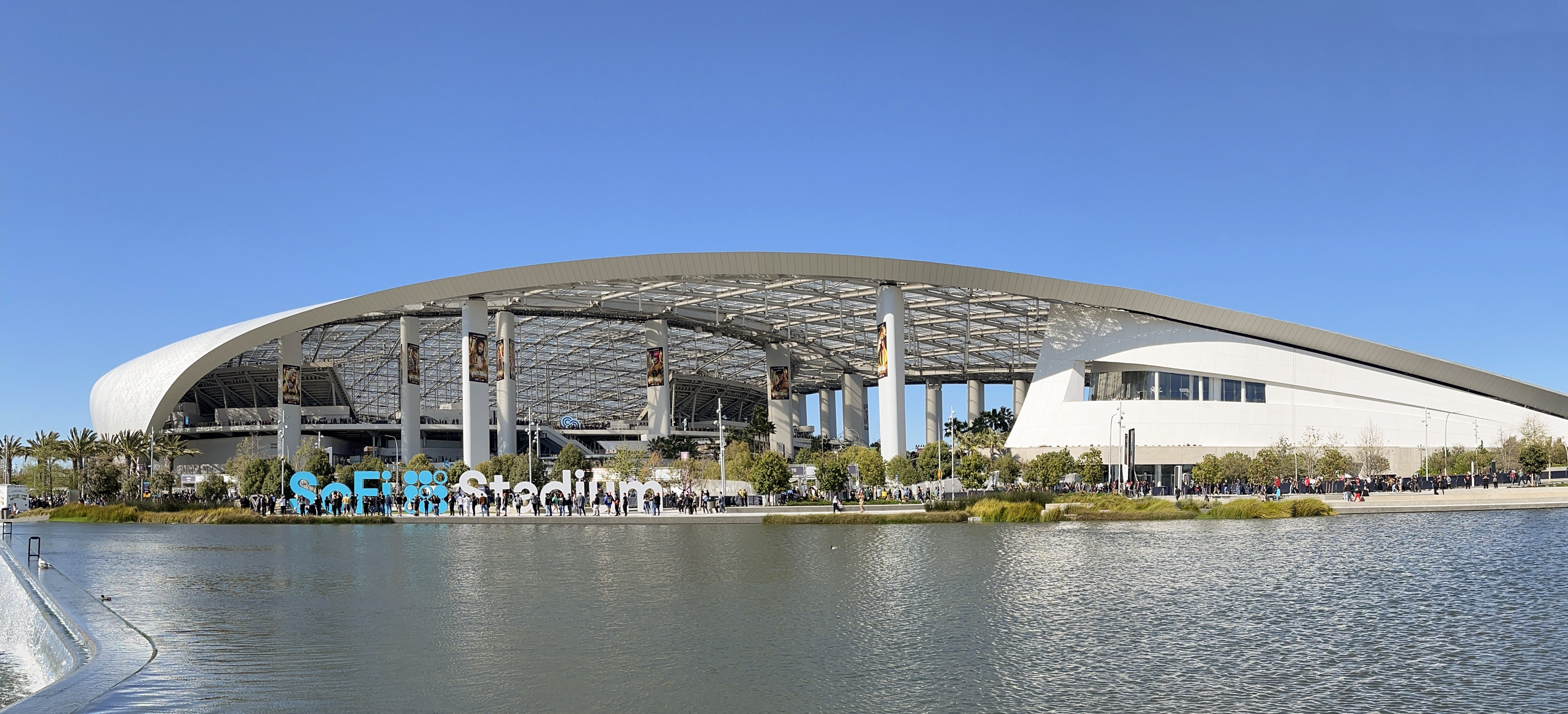|
Estadio Rafael Mendoza
The Estadio Rafael Mendoza Castellón is a multi-purpose stadium in the neighborhood of Achumani, La Paz, Bolivia. It is currently used mostly for football Football is a family of team sports that involve, to varying degrees, kick (football), kicking a football (ball), ball to score a goal (sports), goal. Unqualified, football (word), the word ''football'' generally means the form of football t ... matches and belongs to The Strongest. The stadium has a capacity of 14,000 people. The name was chosen in homage to Rafael Mendoza Castillo (1924-2002), historical president of the club. The stadium was inaugurated on 16 July 1986 with a match between The Strongest and Club Bolivar. References External links Estadio Rafael Mendoza Castellónat Soccerway Rafael Mendoza Rafael Mendoza The Strongest Buildings and structures in La Paz Department (Bolivia) Rafael Mendoza {{bolivia-sports-venue-stub ... [...More Info...] [...Related Items...] OR: [Wikipedia] [Google] [Baidu] |
La Paz, Bolivia
La Paz, officially Nuestra Señora de La Paz ( Aymara: Chuqi Yapu ), is the seat of government of the Plurinational State of Bolivia. With 755,732 residents as of 2024, La Paz is the third-most populous city in Bolivia. Its metropolitan area, which is formed by La Paz, El Alto, Achocalla, Viacha, and Mecapaca makes up the second most populous urban area in Bolivia, with a population of 2.2 million, after Santa Cruz de la Sierra with a population of 2.3 million. It is also the capital of the La Paz Department. The city, in west-central Bolivia southeast of Lake Titicaca, is set in a canyon created by the Choqueyapu River. It is in a bowl-like depression, part of the Amazon basin, surrounded by the high mountains of the Altiplano. Overlooking the city is the triple-peaked Illimani. Its peaks are always snow-covered and can be seen from many parts of the city. At an elevation of roughly above sea level, La Paz is the highest capital city in the world. Due to ... [...More Info...] [...Related Items...] OR: [Wikipedia] [Google] [Baidu] |
The Strongest
Club The Strongest is a Bolivian professional football club based in La Paz, that currently plays in the Bolivian Primera División. Founded in 1908, their team colours are yellow and black. Although they have a home ground, Estadio Rafael Mendoza, (capacity: 15,000), they play most of their games at the Estadio Hernando Siles, Bolivia's national ground (capacity: 42,000). The club is the oldest active football club in Bolivia and the only team to have played continuously in the country's top division for longer than a century. The club was well represented in the Bolivian squad at the 1994 FIFA World Cup, the last such tournament in which the national team participated, by Marcelo Torrico, Gustavo Quinteros, Óscar Sánchez and José Melgar. History Early years The Strongest was founded on 8 April 1908 by a group of 12 students and were originally known as "The Strong Football Club", before later becoming "The Strongest Football Club", or ''El Club Mas Fuerte'' in Span ... [...More Info...] [...Related Items...] OR: [Wikipedia] [Google] [Baidu] |
Multi-purpose Stadium
A multi-purpose stadium is a type of stadium designed to be easily used for multiple types of events. While any stadium could potentially host more than one type of sport or event, this concept usually refers to a design philosophy that stresses multifunctionality over speciality. It is used most commonly in Canada and the United States, where the two most popular outdoor team sports—Canadian football or American football and baseball—require radically different facilities. Football uses a rectangular field, while baseball is played on a baseball field, diamond with a large outfield. Since Comparison of American and Canadian football#Playing area, Canadian football fields are larger than American ones, the design specifications for Canadian facilities are somewhat less demanding. The particular design to accommodate both is usually an oval, although some later designs use an octorad. While building stadiums in this way means that sports teams and governments can share costs ... [...More Info...] [...Related Items...] OR: [Wikipedia] [Google] [Baidu] |
La Paz
La Paz, officially Nuestra Señora de La Paz (Aymara language, Aymara: Chuqi Yapu ), is the seat of government of the Bolivia, Plurinational State of Bolivia. With 755,732 residents as of 2024, La Paz is the List of Bolivian cities by population, third-most populous city in Bolivia. Its metropolitan area, which is formed by La Paz, El Alto, Achocalla Municipality, Achocalla, Viacha Municipality, Viacha, and Mecapaca Municipality, Mecapaca makes up the second most populous urban area in Bolivia, with a population of 2.2 million, after Santa Cruz de la Sierra with a population of 2.3 million. It is also the capital of the La Paz Department, Bolivia, La Paz Department. The city, in west-central Bolivia southeast of Lake Titicaca, is set in a canyon created by the Choqueyapu River. It is in a bowl-like depression, part of the Amazon basin, surrounded by the high mountains of the Altiplano. Overlooking the city is the triple-peaked Illimani. Its peaks are always snow-cove ... [...More Info...] [...Related Items...] OR: [Wikipedia] [Google] [Baidu] |
Bolivia
Bolivia, officially the Plurinational State of Bolivia, is a landlocked country located in central South America. The country features diverse geography, including vast Amazonian plains, tropical lowlands, mountains, the Gran Chaco Province, warm valleys, high-altitude Andean plateaus, and snow-capped peaks, encompassing a wide range of climates and biomes across its regions and cities. It includes part of the Pantanal, the largest tropical wetland in the world, along its eastern border. It is bordered by Brazil to the Bolivia-Brazil border, north and east, Paraguay to the southeast, Argentina to the Argentina-Bolivia border, south, Chile to the Bolivia–Chile border, southwest, and Peru to the west. The seat of government is La Paz, which contains the executive, legislative, and electoral branches of government, while the constitutional capital is Sucre, the seat of the judiciary. The largest city and principal industrial center is Santa Cruz de la Sierra, located on the Geog ... [...More Info...] [...Related Items...] OR: [Wikipedia] [Google] [Baidu] |
Football (soccer)
Association football, more commonly known as football or soccer, is a team sport played between two teams of 11 Football player, players who almost exclusively use their feet to propel a Ball (association football), ball around a rectangular field called a Football pitch, pitch. The objective of the game is to Scoring in association football, score more goals than the opposing team by moving the ball beyond the goal line into a rectangular-framed Goal (sport), goal defended by the opposing team. Traditionally, the game has been played over two 45-minute halves, for a total match time of 90 minutes. With an estimated 250 million players active in over 200 countries and territories, it is the world's most popular sport. Association football is played in accordance with the Laws of the Game (association football), Laws of the Game, a set of rules that has been in effect since 1863 and maintained by the International Football Association Board, IFAB since 1886. The game is pla ... [...More Info...] [...Related Items...] OR: [Wikipedia] [Google] [Baidu] |
Club Bolívar
Club Bolívar () is a Bolivian professional football club that currently plays in the Bolivian Primera División. Founded in 1925 in honor of military leader Simón Bolívar, the club has used light blue kits throughout its history, which is why it is nicknamed "Los Celestes" (The Sky Blues). The club has two stadiums; Estadio Libertador Simón Bolívar, which has a capacity for 5,000 people and is located in the Tembladerani neighborhood of La Paz, is only used for training sessions and friendly matches. Estadio Hernando Siles, which holds a capacity for 41,143 people, is the club's main stadium, and is used for official matches. Bolívar began playing the amateur era two years after its foundation, in 1927, and in the 1932 tournament the club won its first championship title. In the professional era, the club won the first tournament of the Bolivian Primera División in 1950, and since then has won 31 league titles, making it the most successful Bolivian football club. Acco ... [...More Info...] [...Related Items...] OR: [Wikipedia] [Google] [Baidu] |
Football Venues In La Paz
Football is a family of team sports that involve, to varying degrees, kicking a ball to score a goal. Unqualified, the word ''football'' generally means the form of football that is the most popular where the word is used. Sports commonly called ''football'' include association football (known as ''soccer'' in Australia, Canada, South Africa, the United States, and sometimes in Ireland and New Zealand); Australian rules football; Gaelic football; gridiron football (specifically American football, arena football, or Canadian football); International rules football; rugby league football; and rugby union football. These various forms of football share, to varying degrees, common origins and are known as "football codes". There are a number of references to traditional, ancient, or prehistoric ball games played in many different parts of the world. Contemporary codes of football can be traced back to the codification of these games at English public schools during the 19th ce ... [...More Info...] [...Related Items...] OR: [Wikipedia] [Google] [Baidu] |
Buildings And Structures In La Paz Department (Bolivia)
A building or edifice is an enclosed structure with a roof, walls and windows, usually standing permanently in one place, such as a house or factory. Buildings come in a variety of sizes, shapes, and functions, and have been adapted throughout history for numerous factors, from building materials available, to weather conditions, land prices, ground conditions, specific uses, prestige, and aesthetic reasons. To better understand the concept, see ''Nonbuilding structure'' for contrast. Buildings serve several societal needs – occupancy, primarily as shelter from weather, security, living space, privacy, to store belongings, and to comfortably live and work. A building as a shelter represents a physical separation of the human habitat (a place of comfort and safety) from the ''outside'' (a place that may be harsh and harmful at times). buildings have been objects or canvasses of much artistic expression. In recent years, interest in sustainable planning and building practi ... [...More Info...] [...Related Items...] OR: [Wikipedia] [Google] [Baidu] |






